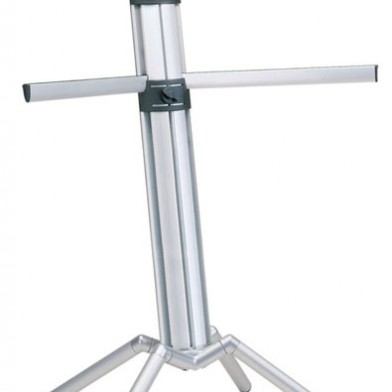How to choose a keyboard stand for a studio?
- 10 August 2020 17:42:17
- Reviews: 0
- Views: 607
-

The keyboard stand in the studio can take a variety of forms. It depends on what we expect from the booth. There are different types of coasters such as "X", double "X", "Z", benches or multi-story.
In general, there are two main criteria by which stands are usually chosen. One of them is the question of whether the stand needs to be rocked or not (each is suitable for a different type of keyboard and turntable). The second question is how many tools the stand should hold.
 As for the first question, i.e., should the bridge oscillate: in particular, classical pianists clearly hate if the bridge oscillates, even if only slightly. They are accustomed from acoustic pianos to a perfectly solid fit of the keyboard in general, and even a slight swipe makes them nervous, they are afraid that the instrument will fall, it affects their psyche, they do not have accurate keystrokes, and all this negatively affects their interpretive abilities. . If you are a pianist or expect pianists to record in your studio, I highly recommend choosing the most stable stands possible. In general, benches are among the most stable. Usually this type of tool has the ability to set the distance between the individual feet. This makes it possible to create a really stable stand even for large instruments with a hammer action keyboard and for example other controls (modulation wheels or joystick, buttons, tape control, etc.) in addition to the keyboard. In general, I can recommend the most durable stand in case there is a tool with a percussion mechanism. Even if the pianist does not play such an instrument, the musician always expects a certain stability under such a heavy instrument.
As for the first question, i.e., should the bridge oscillate: in particular, classical pianists clearly hate if the bridge oscillates, even if only slightly. They are accustomed from acoustic pianos to a perfectly solid fit of the keyboard in general, and even a slight swipe makes them nervous, they are afraid that the instrument will fall, it affects their psyche, they do not have accurate keystrokes, and all this negatively affects their interpretive abilities. . If you are a pianist or expect pianists to record in your studio, I highly recommend choosing the most stable stands possible. In general, benches are among the most stable. Usually this type of tool has the ability to set the distance between the individual feet. This makes it possible to create a really stable stand even for large instruments with a hammer action keyboard and for example other controls (modulation wheels or joystick, buttons, tape control, etc.) in addition to the keyboard. In general, I can recommend the most durable stand in case there is a tool with a percussion mechanism. Even if the pianist does not play such an instrument, the musician always expects a certain stability under such a heavy instrument.
Benches usually also allow you to adjust their height, which is very practical and convenient. On the other hand, the best option is a quality stand chair with which each performer adjusts the height as needed.
Table-type stands usually allow you to attach additional attachments on which you can place other tools. These bits usually already have a different design, so the tools on them already sway a little. I find this to be a good option if you need to fit more instruments on the same rack, especially if it's one instrument with a percussion mechanism and the other with a synth keyboard.
Some bleachers can be built on wheels to make them easier to move around the studio. However, I recommend checking to see if the wheels can be locked securely so that the tools don't move under your hands. At the same time, it is necessary to think about whether the mobility of keyboards after study is really so important and whether cables will still significantly interfere with it. Personally, I prefer a fixed location.
A second fixed, non-moving option would be the "Z" type strut. Unlike the "X" pillars, this "Z" can be seen from the side instead of the front. However, even "Z" stances sometimes sway slightly from player to player. They also don't offer adjustable foot spacing, so larger keyboards can make them less stable in the left-to-right direction. In general, I would recommend these stands more for lighter tools with no impact action. In this case, on the contrary, these instruments usually make a very solid and stable impression.
"X" stands are commonly and readily used by classical synthesizers, especially by those who frequently play live on stage. The great advantage of these stands is, above all, the possibility of easy installation and, consequently, transportation. That is why they are so often used for live performances and why many musicians are used to them. However, these racks do not provide much stability. Double X's are logically much more stable than single X's, especially in player-to-player direction. Due to their lesser stability, lighter and smaller keyboards are usually placed on "X" stands. The height of the stand can also be adjusted so that they can be used for seated and standing play. However, as the height increases, the posts tend to become narrower and even less stable. Various attachments for other tools are also produced for "X" type racks.
The last type of stands are multi-storey racks, the so-called "spiders". Such stands usually have two to three floors. Their stability is higher than that of the “X” type racks, but they also sway a little. These types of stands are also used for live performances as they usually also make it easier to assemble and disassemble. The height of each floor is usually chosen. The main advantage of these stands is the ability to accommodate more instruments on one stand with relatively high stability. However, it is necessary to monitor the maximum load capacity of the stand and the total weight of all stacked tools, and there are also special racks adapted to certain models.


